Gravity is one of the more obvious forces in the universe, generally regarded as easily noticeable by the way apples fall from trees. However, the underlying mechanisms behind gravity are inordinately complex, and the subject of much study to this day.
A major component of this study is around the concept of gravitational waves. First posited by Henri Poincaré in 1905, and later a major component of Einstein’s general theory of relativity, they’re a phenomena hunted for by generations of physicists ever since. For the team at the Laser Interferometer Gravitational-wave Observatory, or LIGO, finding direct evidence of gravitational waves is all in a day’s work.
What Are Gravitational Waves Anyway?
Gravitational waves are ripples in spacetime itself, caused due to accelerating masses with some form of asymmetry. For example, a dumbbell spinning about its main axis would not generate gravitational waves, nor would a spinning sphere or a flat disc. However, a dumbbell tumbling end over end, or one with a significant asymmetry, would generate gravitational waves. Most sources of gravitational waves are due to major cosmological-scale events, as the larger the masses involved, the larger the gravitational waves that are created. Typical sources include binary star systems, where two large stars orbit around each other, or binary black holes. Supernova explosions asymmetrically accelerate huge amounts of mass, so should also create gravitational waves. In rare cases, incredibly dense spinning neutron stars that aren’t quite perfectly spherical should also cause such waves, due to surface irregularities that make them asymmetrical — though these are yet to be detected in practice.
Detecting Gravitational Waves
A gravitational wave distorts spacetime, squeezing it together or stretching it apart as it passes. Unfortunately for the hard working physicists of the world, the interaction between gravitational waves and matter is very weak. Combined with the fact that the strength of gravitational waves grows weaker with the inverse of the distance of the source, detecting gravitational waves is very difficult indeed.
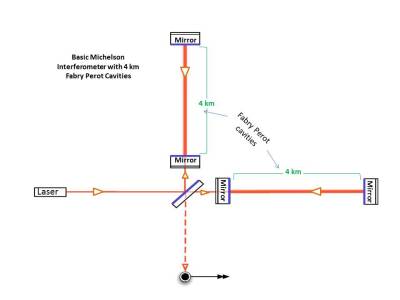
Using conventional measuring devices isn’t viable for investigating such phenomena. LIGO has to measure changes in distance under 10,000 times the size of a proton (or around 8.4 x 10-20 m) to determine the effect of gravitational waves on its detectors. It does this with an L-shaped laser interferometer. A laser beam is fired at a 45 degree beam splitter, which sends some light down one leg of the L, and the rest of the light down the other. At the end of each leg is a mirror, which bounces the light back. The light from each leg is then recombined and shined on a photodetector. As the length of each leg of the L changes, the light travels a different distance on each path.
When when the reflected light is recombined, an interference pattern is generated because the light from each path constructively and destructively interferes. This interference pattern can then be used to determine the length of each leg incredibly accurately, and thus used to determine if a gravitational wave has passed by, distorting space time around the interferometer. The longer an interferometers legs, the more sensitive it is to gravitational waves, hence each leg of LIGO’s interferometer is a full four kilometers long.
To further improve sensitivity, the interferometer features what are known as Fabry Perot cavities, which bounce the light back and forth down each leg 300 times before it reaches the photodetector. This has the effect of causing the laser light to travel 1200 kilometers up and down each leg before it reaches the detector, greatly increasing the sensitivity to minute changes in the size of each leg.
Stabilising the Instruments
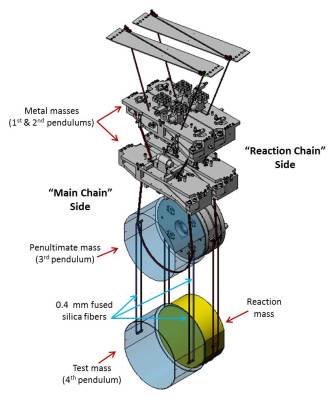
If building a gigantic 4km-per-side interferometer didn’t sound hard enough, don’t worry — there’s more to it. With the minute changes in distance being measured, even a slight rumble from a passing truck or distant earthquake could shake the interferometer assembly enough to ruin any measurements. To prevent this, an active damper system is used to stabilise the system. A variety of sensors detect tremors and environmental vibrations, and counter-motion is generated to keep things steady.
Additionally, the mirrors themselves are hung from a four-stage pendulum, called the “quad”, to keep disturbances to a minimum. The heavy 40 kg weight of the system’s mirrors, or “test masses”, also helps stability thanks to pure inertia. The entire light path is also kept at vacuum of one-trillionth of the air pressure at sea level, as errant air molecules bouncing around create noise that disrupts sensor readings.
The LIGO system is actually one of the world’s largest vacuums by volume, with the Large Hadron Collider in Switzerland being notable as a larger example. Achieving this vacuum is no mean feat. With the tubes first heated to drive out as much residual gas as possible, a series of turbo-pumps and ion pumps were used to drive down the pressure inside. It took a full 40 days to bring each tube of LIGO down to the requisite vacuum level. The interferometer arms have been maintained at vacuum since the 1990s; gate valves are used to seal off the corner chambers for maintenance and upgrades where necessary.
A 200 Watt Laser Isn’t Messing Around
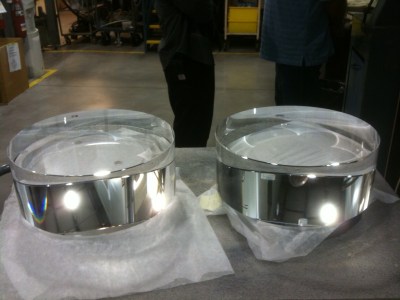
The laser used in LIGO is also vital to the performance of the detector. With a stronger, more powerful laser beam, the signals picked up by the photodetector are less likely to be disturbed by noise. “We want as many photons interacting with the test mass as we can,” says Georgia Mansell, a post-doctoral member of the LIGO Commissioning Team. The Advanced LIGO upgrade fitted the facilities with a 200W laser system, though the full power level has not been used in practice yet. “In our last observing run, we had a problem where there’s a point defect in one of the test mass coatings… it absorbs a lot of heat and creates a weird thermal profile in the optic. In the end we used 40 watts in the last observing run.” In January 2021, the defective test mass was replaced, and the interferometer began undergoing preparations for its next observing run.
Somewhat uniquely to LIGO among large physics installations is that it isn’t a single facility. Instead, the entire interferometer assembly was built twice, in two separate locations — the LIGO Livingston Observatory in Louisiana, and the LIGO Hanford Observatory in Washington. This has the benefit of allowing the system to correlate potential gravitational wave findings across the two locations. This can help with ruling out phenomena like vibrations due to traffic or seismic activity from genuine gravitational wave detections.
Observations
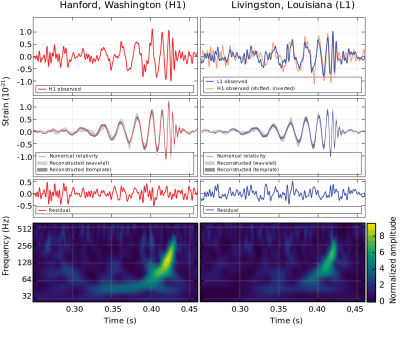
The first direct gravitational wave detection was made on the 14th of September 2015, detected by both the LIGO observatories at the time. Since then, many more successful observations have been made, with the most recent observation run netting 55 detections before being curtailed by COVID-19. With the existence of gravitational waves confirmed by direct observation, work is ongoing to better understand the phenomena. Each detection comes from a different stellar event, and sheds more light on the underlying physical processes at play. The biggest detection yet was from May 21, 2019, likely due to the merger of two black holes. Data is compared between the two LIGO observatories, as well as a similar facility in Italy by the name of VIRGO, to help pinpoint the source of any observed waves.
Being able to detect gravitational waves enables the investigation of phenomena that were difficult to access with traditional optical or electromagnetic astronomy.
Before LIGO, we didn’t really know how many binary black holes there were in the universe… you can’t really see them. What LIGO is sensitive to is that final moment where they merge … We’re doing some cool stuff with the distribution of binary black holes… they could be isotropically distributed through the universe, or there could be more black holes in certain systems.
As more measurements roll in, and physical theories evolve, the data collected from the project may shed further insights on the very structure of the universe itself.
The LIGO experiment is a great example of the level of sophistication required to investigate the phenomena at the cutting edge of physics. Often, there’s a huge lag between theories being proposed and successful experimental confirmations; in this case, a full century went by before gravitational waves could be directly detected. It’s hard work untangling the secrets of the universe, but as always, scientists stand ready to rise to the challenge.
[Thanks to Georgia Mansell of the LIGO project who consulted on this article! Her livestreams working on LIGO’s interferometer can be seen on Twitch.tv.]

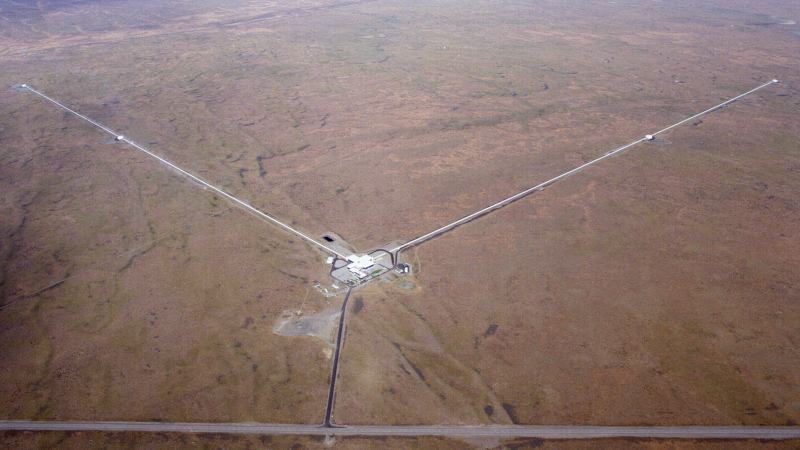














Simply amazing! Thank you for such a concise but detailed explanation.
Glad you enjoyed it!
Amazing work being done by the LIGO Project, and a great example on why it’s important to fund big experiments!
Absolutely. Cutting edge physics is often 50-150 years ahead of engineering, but if we’re not making new discoveries, we’re not going anywhere.
Did you mean 8.4 x 10–²⁰m ? 8.4 x 10²⁰m would suggest a pretty phat proton.
Protons as big as your galaxy!
Fixed, thanks. What’s a couple orders of magnitude between friends?
https://www.youtube.com/watch?v=iphcyNWFD10
Was a pretty decent video / explanation of LIGO from about 4 years ago.
I thought the big hubbub over the discovery of gravity waves (a few years ago) involved a satellite.
You’re thinking of the LISA Path Finder, and yes, it did also confirm I believe the third reading seen by LISA along with VIRGO during its test flight.
I’m not sure thinking of gravity as a force is correct. The units seem wrong, for one thing. Secondly, since F/m=a, if gravity was a force the acceleration would depend on the mass, which the feather/hammer experiment on the moon proves it doesn’t.
“Secondly, since F/m=a, if gravity was a force the acceleration would depend on the mass”
Not if the force depended on the mass as well, which it does.
But regardless, you don’t want to be thinking of a force as some kind of a special “thing” that something “is” or “isn’t”. A force is just *defined* as a change in momentum. If there’s a change in momentum in time, there’s a force. Period. It’s just the definition of the term. There’s no other consideration. It’s not like “mass” where there’s a vague definition you need to qualify.
What gravity “really is” is totally separate. Gravity obviously *exerts* a force since there are momentum changes due to it.
You believe that anyone actually went to the moon and conducted experiments?
Mass != weight
This bugs me to no end, in that physics-pedant way.
In Imperial, lbs is a weight, and what exactly are the units for mass?
At least in SI there are kg and N, but then everyone goes around quoting their weight (measured with force sensors — a scale) in kg, the units for mass. Go figure.
How hard do you have to push it? A force. How much does it resist being pushed? A mass. Their ratio? The acceleration when you do the pushing.
Gravity is just always accelerating.
Imperial mass unit is the Slug:
https://en.wikipedia.org/wiki/Slug_(unit)
“everyone goes around quoting their weight (measured with force sensors — a scale) in kg, the units for mass”
The scales divine our mass by measuring the force, technically the resultant force of the effect of the planet on your body and the reaction force of the floor pushing against the scales. The scales don’t work properly on the moon because they’re calibrated for `g` on Earth. That makes me wonder what it would be like to weigh myself in a lift (an elevator) as it accelerates or decelerates.
you will have a blip on acceleration and decel. but while going up the building at a steady velocity your weight will remain the same.
I suspect that when humans live on Mars they will still say “I weight 60 kilos” even though the reading on the scale would be something around 200 Newtons of force.
The Metric folks I know quote their weight in “stone”, not kilograms or Newtons.
F/m=a is the equation for calculating the acceleration for a single object. In case you missed that part of physic in school that talked about it, Newton determined that the force due to gravity for two objects, the feather and the moon, or the hammer and the moon as demonstrated in the Apollo experiment, the F in your equation would be replaced with G*(m1*m2)/r^2 where m1 would be the mass of the moon, and m2 would be the mass of the feather or the hammer. If you plug the force of gravity into the F/m=a formula, the mass of the “feather” cancels out for it’s acceleration towards the moon. If you solve for the acceleration for the moon towards the feather, or the hammer, you find that it becomes a rounding error. So… nope.
One interesting feature is the location of one of the instruments in Eastern Washington. Most of the Eastern part of the State is covered by huge basalt lava flows up to 3 miles deep that have been there for about 17 million years and are very stable.
I think “force” here is understood in the sense of “fundamental force” [1], not as that classical physical quantity “force” measured in N [2]
[1] https://en.wikipedia.org/wiki/Fundamental_force
[2] https://en.wikipedia.org/wiki/Force
Fundamental forces are still forces. They cause changes in momentum, therefore, forces. At the particle physics level you tend to work in potential energy, but you can always just take the gradient to get the force. The attractive portion of the nuclear force between two nucleons, for instance, peaks at like, 25 kN. Even the Standard Model is just a bunch of terms in a Lagrangian formulation, with each term being a potential term.
Gravity at the GR level gets weirder because the formulation is *very* different from classical mechanics, but that part doesn’t matter – you calculate the force on an object the same way, just as the change in momentum.
Gravity isn’t a force, it’s a curvature. :)
Bjork, however, is a force to be reckoned with.
It’s still a force. There’s a fair number of crowing from people arguing “oh, gravity’s different, it’s an emergent property blah blah blah,” but that’s more of a “unification” argument – and really, it’s *silly*.
Why? It’s coming from people who think you can’t unify gravity like you hope to with strong/electroweak, and like you *did* with electromagnetic/weak. In that, in the end, you’ll be left with “gravity” (weird emergent) and “supersymmetric gauge-y thing” (strong/electroweak).
But look at the electroweak unification: the argument “oh, electromagnetism and the weak force aren’t two separate forces! they’re 1 force, broken by the Higgs field!” is bullcrap. Why? Because you’re *refusing the acknowledge the Higgs interaction as a new force*, and that interaction *is not* unified with the electroweak. And it’s entirely possible the strong/electroweak unification (if possible!) will come from *another* field you need to integrate in, which means hey, you get a new force there too.
It’s all just particle physics preferences. We’ve got this 50+ year old idea of “four fundamental forces” which, by now, is just total nonsense. You’ve clearly got the Higgs Yukawa coupling, which is damn well a force: it’s a freaking potential, I can take its gradient, and that’s a force (it’s actually the only one you can actually solve!). And you’ve obviously got both inflation and dark energy to explain, which is *at least* one *more* thing to deal with.
Sorry, pet peeve. If you want to see most particle physicists cringe (well, *other* ones than me, I guess) ask them why the Higgs self-coupling isn’t a force, and when they bullcrap an explanation ask them “but… I can solve for its equations of motion, and last time I checked, they show a change in momentum, which… is a force.”
Anyway. Whatever “underlying mechanism” exists for gravity, it exerts a force. It changes momentum, therefore… it’s a force.
This is an honest question, not trolling: At first you said gravity _is_ a force, and at the end you said it _exerts_ a force. From a physics perspective is that the same thing?
That’s a lot of the gist of what my pet peeve is: a force is a change in momentum. Full stop, that’s the definition, period. Newton’s second law is a law because force has no other definition.
But then physicists got sloppy and started talking about “fundamental forces” and people started thinking of them as “things” as opposed to arbitrary classifications, like planets in astronomy. Then just like you have dumb arguments like “is Pluto a planet,” you have dumb arguments like “is gravity a force.”
Whereas, truthfully, none of the “fundamental forces” should’ve ever been called “forces” in the first place. They’re fundamental *fields*, and they exert forces because they have a potential. We later found out that some of those fields (the electromagnetic and the vector fields of the W/Z bosons) are actually just subsets of a different field (the electroweak field). So then people started saying “oh, electromagnetism and the weak force are just the same force!” – but at the same time that meant there was a *new* field (the Higgs field) with its own, completely separate potential – and no one wanted to call that a force, for some weird reason.
TL;DR: I’m being sloppy in language just like all the silliness that caused this years ago. All a force *is* is a change in momentum. The *fields* are the real things, and of course whatever causes the force of gravity is a field, since Einstein’s equations are field equations, after all.
So you might ask “OK, then how many fundamental fields are there?” and that’s a much tougher question. From particle physics, you’ve got 5 totally different (lepton, quark, gluon, electroweak, and Higgs). From gravity, you’ve got 1 (spacetime), but from astrophysics you’ve got 2 more (dark energy and the inflaton field).
All of those fields are “fundamental.” Some of them might be different aspects of the same thing. But the whole “is it a force” thing is just silly pedantics.
Just to clarify one thing: you might *also* say “wait, wait, those ‘fundamental forces’? We actually meant those as ‘fundamental interactions! As in, they’re how the *different fields* interact!”
Which starts to become better, but again, it’s still pedantics to say “these 4 are special!” Gravity is *still* one of those, because it results in an interaction between *all* fields (just… really weak). And you still would have dark energy (which is a *different* interaction as of now), inflation (again, still different as of now) and also the Higgs interaction.
I also should’ve nominally said that dark matter must be an additional field as well right now, and who the heck knows what interactions exist *there*.
Thanks, Pat, you really know what you’re talking about. So is it more accurate to say “gravity is a field. That field exerts a force on mass.” If so, then saying “gravity is a force” is a shortcut to that longer version, yes?
I’d say “gravity is matter telling spacetime how to curve.” That also neatly splits off dark energy from gravity: Einstein’s field equations look like “spacetime curvature = constant*(matter/energy tensor) + dark energy”. So the ‘gravity’ part is the first term, ‘dark energy’ is the second.
If you want to be pedantic you could add “matter-energy field telling the metric field” but the first is more poetic.
It’s a curvature in one theory, not in all possible theories. We know GR is incomplete too, because of singularities.
Writing it as a curvature is just a way of formulating the math. It’s just like the difference between using basic equations of motion and a Lagrangian or Hamiltonian formulation. I don’t care *what* the underlying theory is, I guarantee I can write it in some limit as curvature.
Many GR texts have a section showing how you can formulate Newtonian gravity in the same sense, as a geodesic equation with the world’s most boring stress-energy tensor. Similarly, I don’t care what goofy alternative gravity you want to use, you can reformulate it as a geodesic equation as well.
“There is no gravity, the Earth sucks!”
-graffiti
It’s not entirely stable. Back in 2005 when there was seismic activity in Rainier and other mountains in the Cascades, LIGO was periodically knocked out of lock.
Additionally, the instruments are so sensitive that earthquakes on the other side of the planet could knock it out of lock, due to the propagation of seismic waves through the earth itself.
“This interference pattern can then be used to determine the length of each leg incredibly accurately” … I think the interference patterns can be used to determine the /difference in length/ extremely accurately.
I’m too lazy to look up the numbers, but if LIGO can detect a couple of black holes orbiting each other at distances measured in light years, then it ought to be able to detect a few Kg of plutonium turning into energy 13000 KM away if the stuff does it rapidly enough – i.e., nuclear test ban treaty violations. And since these happen within a few kilometers of the earths’ surface, max, then the pair should be able to locate the test site. Just a thought. Coincidentally, it’s no secret the Ice Cube neutrino detector is partially funded through the comprehensive test ban treaty. E=MC^2 . They’re called weapons of MASS destruction for a reason – the universe gets a few kilograms less massive each time one goes off.
LIGO could be an incredibly expensive earthquake detector, yes! That said, your average seismograph does a great job at detecting nuclear detonations already.
wow, here is alot of “nanotechnologie” to unpack here. 1st I also doubt the exitance of black holes becuase “its mathematicaly proofen/possible”. E=MC^2 is not matter and motions, its matter equals energy. And about the nano drones and stuff: use an acid or a base. you dont need nano anything, those would also just boild down to an acid. Inhale SO and it form acid in your lungs and destroxes them. Smae with HCl or alot of other stuff, chemistriy basicly is nanotechnologie.
In Europe there is a race going on about which country will get the opportunity to build an underground Einstein Telescope. Here in Limburg we have good chances because of the geological stable ground and it would deliver lots of jobs.
Here is a short video of about a year ago, concerning the process: https://l1.nl/l1mburg-centraal-komt-de-einstein-telescoop-naar-limburg-152425/
Pro tip: it doesn’t, because the phenomenon is nonsense. Imagine how embarrassing it’ll be when these gravitational waves are found out to be cars on the highway above, or caterpillars scratching in the dirt or, literally, anything but black holes violating the information paradox.
Unsure why you think gravitational waves would violate the information paradox.
Assuming you mean that mass entering a black hole causes information to be destroyed, I don’t see what gravitational waves have to do with it at all.
And if you mean information traveling faster than light, then gravitational waves travel at the speed of light. It’s literally a prediction of the light speed limitation of general relativity.
Also if you read the article it explains there are two locations far apart, and a similar one in Italy, and they corroborate each other eliminating the possibility of point disturbances like that. I imagine the guys running it are probably smart enough to put together some statistical and signal analysis that gives a high confidence that the data is not random noise or interference.
I heard somebody mention that our intestines are actually very long when fully stretched out. Gross as it is, the way intestines are all wrapped up and compacted inside of us made me think of the LIGO.
The path of the light is “compacted” by bouncing it back and forth. I would be ecstatic if they found even better ways to reduce the total volume of GW detectors!